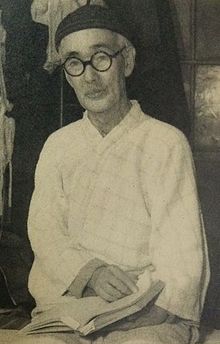From Wikipedia, the free encyclopedia
Japanese author (1883?1962)
 Ujaku Akita
Ujaku Akita
Ujaku Akita
(
秋田 雨雀
,
Akita Ujaku
, 30 January 1883 – 12 May 1962)
was the
pseudonym
of
Tokuz? Akita
(
秋田 ?三
,
Akita Tokuz?
)
, a
Japanese
author and
Esperantist
. He is best known for his plays, books, and short stories for children.
Biography
[
edit
]
Born in
Kuroishi
,
Aomori Prefecture
, he studied
English literature
at
Waseda University
and became interested in
socialism
. In 1913 he learnt Esperanto from
Vasili Eroshenko
, as a result of a chance meeting, and soon became a leader of the proletarian Esperanto movement, and a member of the "La Semanto" group in 1921. He visited the
USSR
in 1927 for the celebrations of the tenth anniversary of the
revolution
. In January 1931 he helped found the national organization,
Japana Prolet-Esperantista Unio
(JPEU), with about 150 members, and with Akita as president. He translated Eroshenko's writings into Japanese, and wrote a textbook on Esperanto.
[
citation needed
]
The rise of militarism in Japan led to difficulties for Akita; in the autumn of 1933 he was detained for several weeks, and forced to write a long statement about his activities.
[1]
Nevertheless, he continued to work, founding a magazine the next year,
Teatoro
(named after the Esperanto word for theatre), which still exists.
[2]
He joined the New Cooperative Theatre (
Shinky? Gekidan
) but its activities were limited because it was no longer safe to stage plays with political themes.
[3]
The JPEU was shut down by the police.
[
citation needed
]
After the war he established a performing arts school and was active in other organizations, such as the New Japan Literary Society (
Shin Nihon Bungakukai
) and established the Japan Militant Atheists' Alliance (
Nihon Sentokteki Mushinronsha Domei
).
[4]
He died in 1962. A museum in his hometown was opened in 1979.
[
citation needed
]
Selected works
[
edit
]
In Japanese
[
edit
]
- Higashi no Kodomo
("Children in the East", anthology, 1921)
- Taiyo to Hanazono
("The Sun and the Flower Garden", anthology, 1921)
- Mohan Esuperanto-Dokusyu: Memlernanto de Esperanto
("Esperanto by Self-Study", with
Osaka Kenji
, textbook, 1927)
- Ujaku jiden
("Autobiography", 1953)
Translated into Esperanto
[
edit
]
- Tri dramoj
("Three plays" translated in 1927 by Ha?ime ?uzui, Kaname Susuki)
- Fonto de sudroj
("
Shudras
' Fountain")
- Danco de skeletoj
("Skeleton Dance")
- Nokto ?e landolimoj.
("Night at the Frontiers")
- Tiuj, kiuj ?irka?as la ?erkon
("Those who gather round the coffin" translated c. 1925 by Junko Sibata)
Notes
[
edit
]
- ^
Janus-faced justice: political criminals in imperial Japan.
By Richard H. Mitchell. University of Hawaii Press, 1992. Page 92.
- ^
Japan encyclopedia.
By Louis Frederic. Translated by Kathe Roth. Harvard University Press, 2005. Page 955.
- ^
Kabuki's forgotten war: 1931-1945.
By James R. Brandon. University of Hawaii Press, 2009. Page 64.
- ^
A Blueprint for Buddhist Revolution: The Radical Buddhism of Seno'o Giro (1889-1961) and the Youth League for Revitalizing Buddhism
By James Mark Shields. Japanese Journal of Religious Studies, 2012. Page 339.
External links
[
edit
]
|
|---|
| International
| |
|---|
| National
| |
|---|
| Academics
| |
|---|
| Other
| |
|---|